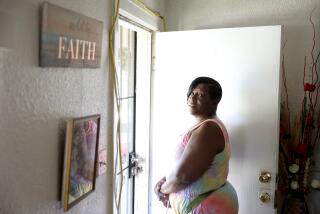There’s Life After Foster Care
- Share via
I am a 19-year-old former foster youth, one of about 1,000 youth who “age out” of the foster care system each year. I had been in foster care since I was 12 years old because my parents could no longer take care of me.
I have lived all over Los Angeles County, in group homes, foster homes and emergency shelters. I experienced a lot of pain and suffering during these years, sometimes thinking I would not survive being a foster child. All I ever really wanted was to go home and live with my family. When I was told that I could not go home, I started causing trouble, which led to my attending eight high schools in four years. My grades went from A’s and Bs to Ds and Fs.
Because I was always moving, I never had the opportunity to establish long-lasting friendships so I came to believe that the only way for me to survive was to join a gang. The gang members I called friends were the same ones I was getting into trouble with. Although people tried to help, I felt that there was no salvation for me and I saw no future in myself. I eventually lost hope.
When I turned 16, I was introduced to a new program called Bridges to Independence, which is affiliated with United Friends of the Children. I learned that a group of concerned citizens in Los Angeles, who had been caring for abused and abandoned foster children for more than 20 years, had started a new program to help youth who must leave foster care at age 18. There were people all over Los Angeles County who cared about my future. For the first time since I was 12 years old, I felt like maybe my life was worth living.
The Bridges to Independence program provides support, care and love to young adults as they leave foster care. Bridges’ programs, in partnership with the Department of Children and Family Services, the Community Development Commission and the Department of Housing and Urban Development, provide transitional housing, social workers, job training and independent living skills to assist youth just like myself.
In 1997, I was one of the first youths to enter the Bridges transitional housing program, which kept me from becoming homeless. Today, there are almost 200 foster youth living in apartments all over Los Angeles County, learning basic living skills like cooking, shopping and money management while also learning to become contributing members of their communities. Bridges also has a career center that provides job preparation and employment opportunities.
I am now attending Santa Monica Community College, working two part-time jobs, one as an instructional assistant for disabled students. On weekends I work as an administrative assistant in a law firm. My long-term goal is to finish school and work in the entertainment industry.
Within the next few months I will be leaving the transitional housing program, now that I have found my own apartment and have a secure job and a car.
Because of the Bridges program and the unconditional support of my social worker, Belinda Gibson, I am ready to lead an independent, successful life. I am proud to have learned what it means to be responsible for myself.
But my proudest moment came on Jan. 29 when I was invited to speak at the White House to First Lady Hillary Rodham Clinton and Tipper Gore, Vice President Al Gore’s wife, about the plight of emancipating foster youth. Who would have thought that I would be speaking at the White House, representing the thousands of foster youth who find themselves at 18 alone, scared and without a home or family to rely on?
I am grateful that an organization like Bridges was created to help foster youths like myself but I am most grateful that I can bring attention to this issue. And I hope that by sharing my story, emancipated foster youths will never again be alone or forgotten.
More to Read
Sign up for Essential California
The most important California stories and recommendations in your inbox every morning.
You may occasionally receive promotional content from the Los Angeles Times.










